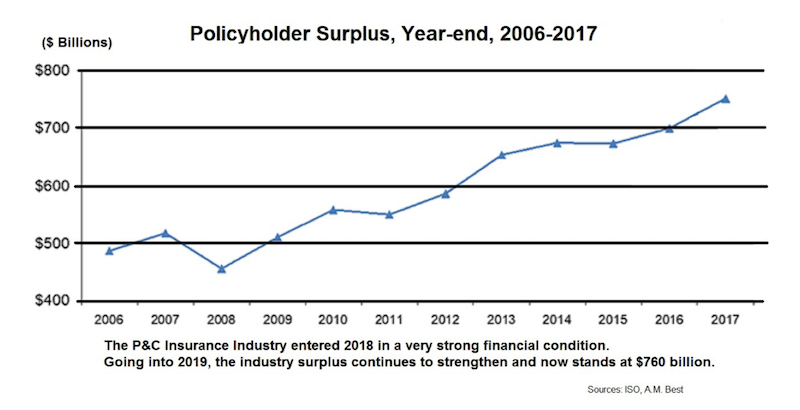The commercial property and casualty (P&C) market is driven by two powerful, albeit conflicting, forces: large catastrophic losses and excess capital. As a substantial part of real estate development is happening in areas exposed to floods, wildfires, severe storms, hurricanes and earthquakes, insurance companies are rethinking how to deploy their capital to manage aggregation in catastrophe exposed areas.
USI Insurance Services, a global insurance brokerage and consulting firm, recently released its 2019 Commercial Property & Casualty Market Outlook, which provides insight into the current dynamics of the property and casualty insurance market, as well as a deeper dive into covered sectors that include commercial real estate and construction, transportation, manufacturing/distribution, environmental, and aviation.
The report found a stable P&C industry in 2018, despite it having experienced five of the 15 costliest global catastrophes in the past two years, coupled with multiple large wildfires and other major loss events, which collectively caused in excess of $125 billion in total insured damages.
The P&C industry remains well capitalized, and its surplus now stands at $760 billion. Consequently, the industry has resisted significant and sustained market-wide rate increases, even as insured property losses from U.S. catastrophes alone went from $14.3 billion for 2.4 million claims from 33 catastrophes in 2010 to $101.9 billion for 5.2 million claims from 46 catastrophes in 2017, according to Property Claims Services and the U.S. Bureau of Economic Analysis.
It remains to be seen whether such restraint is sustainable if catastrophic events continue to increase and wreak havoc. USI says while most insureds should expect a flat to plus-5% rate change, but cautions that current rate trends will be difficult to maintain if the frequency and severity of catastrophes don’t abate.
The report notes specifically that pricing challenges are likely to persist in specific coverage lines such as property-exposed accounts in wind-prone areas, habitational risks, and large commercial trucking fleets.
Carriers, says USI, are also more likely to ask for moderate-to-high rate increases for many insureds in the public company directors’ and officers’ space, employment practices liability and medical malpractice for healthcare providers in certain classes.
Within the commercial real estate sector, multifamily properties could have the hardest time finding willing insurers. Beyond the natural catastrophe losses in 2017 and 2018, multifamily portfolios are producing fire and water damage losses, causing some carriers to either exit this risk class entirely, or increase rates and deductibles even for low-loss level insureds. With overall segment capacity shrinking, insureds with exposures to natural catastrophe and below average loss history can expect significant rate increases.
This could be especially true for frame construction, due to numerous large fire losses in recent years.

Despite the frequency of catastrophic events, insurers have so far resisted steady and high rate increases. Image: USI
The prospects are a bit brighter for nonresidential commercial properties, whose owners, developers, and managers have a distinct advantage, says USI: Quality risks remain the focus of carrier capacity offerings. Nevertheless, portfolios exposed to natural catastrophe will require a disciplined approach to achieve an optimal outcome in the marketplace.
USI joins other market observers in its expectation that spending on commercial construction will rise in 2019. Total construction spending may produce a 4% increase in insurance premiums in 2019, compared to 2018, while rates remain mostly flat in certain jurisdictions.
For larger construction projects, safety, specialization, timeliness, and staying within budget remain the biggest risks. “With good risk management and the use of Controlled Insurance Programs (CIPs), insureds can avoid disruptions, reduce loss costs, and meet expectations of all parties who have an insurable risk,” USI’s states.
Its report found in commercial construction a greater emphasis on jobsite safety to reduce claims per man-hour. The widespread application of BIM is fostering open collaboration and new ideas that are helping to mitigate risk, too.
USI also comments on the renewed interest in modular and prefabricated construction, which brings with it benefits of quality control and worker safety. However, those methods also raise insurance-related concerns, such as how a general liability insurance policy would respond to a potential claim, and how employees should be categories within their workers compensation programs.
Related Stories
Museums | Mar 11, 2024
Nebraska’s Joslyn Art Museum to reopen this summer with new Snøhetta-designed pavilion
In Omaha, Neb., the Joslyn Art Museum, which displays art from ancient times to the present, has announced it will reopen on September 10, following the completion of its new 42,000-sf Rhonda & Howard Hawks Pavilion. Designed in collaboration with Snøhetta and Alley Poyner Macchietto Architecture, the Hawks Pavilion is part of a museum overhaul that will expand the gallery space by more than 40%.
Affordable Housing | Mar 11, 2024
Los Angeles’s streamlined approval policies leading to boom in affordable housing plans
Since December 2022, Los Angeles’s planning department has received plans for more than 13,770 affordable units. The number of units put in the approval pipeline in roughly one year is just below the total number of affordable units approved in Los Angeles in 2020, 2021, and 2022 combined.
BIM and Information Technology | Mar 11, 2024
BIM at LOD400: Why Level of Development 400 matters for design and virtual construction
As construction projects grow more complex, producing a building information model at Level of Development 400 (LOD400) can accelerate schedules, increase savings, and reduce risk, writes Stephen E. Blumenbaum, PE, SE, Walter P Moore's Director of Construction Engineering.
Sports and Recreational Facilities | Mar 7, 2024
Bjarke Ingels’ design for the Oakland A’s new Las Vegas ballpark resembles ‘a spherical armadillo’
Designed by Bjarke Ingels Group (BIG) in collaboration with HNTB, the new ballpark for the Oakland Athletics Major League Baseball team will be located on the Las Vegas Strip and offer panoramic views of the city skyline. The 33,000-capacity covered, climate-controlled stadium will sit on nine acres on Las Vegas Boulevard.
Adaptive Reuse | Mar 7, 2024
3 key considerations when converting a warehouse to a laboratory
Does your warehouse facility fit the profile for a successful laboratory conversion that can demand higher rents and lower vacancy rates? Here are three important considerations to factor before proceeding.
Shopping Centers | Mar 7, 2024
How shopping centers can foster strong community connections
In today's retail landscape, shopping centers are evolving beyond mere shopping destinations to become vibrant hubs of community life. Here are three strategies from Nadel Architecture + Planning for creating strong local connections.
Market Data | Mar 6, 2024
Nonresidential construction spending slips 0.4% in January
National nonresidential construction spending decreased 0.4% in January, according to an Associated Builders and Contractors analysis of data published today by the U.S. Census Bureau. On a seasonally adjusted annualized basis, nonresidential spending totaled $1.190 trillion.
MFPRO+ Research | Mar 6, 2024
Top 10 trends in senior living facilities for 2024
The 65-and-over population is growing faster than any other age group. Architects, engineers, and contractors are coming up with creative senior housing solutions to better serve this burgeoning cohort.
Office Buildings | Mar 5, 2024
Former McDonald’s headquarters transformed into modern office building for Ace Hardware
In Oak Brook, Ill., about 15 miles west of downtown Chicago, McDonald’s former corporate headquarters has been transformed into a modern office building for its new tenant, Ace Hardware. Now for the first time, Ace Hardware can bring 1,700 employees from three facilities under one roof.
Green | Mar 5, 2024
New York City’s Green Economy Action Plan aims for building decarbonization
New York City’s recently revealed Green Economy Action Plan includes the goals of the decarbonization of buildings and developing a renewable energy system. The ambitious plan includes enabling low-carbon alternatives in the transportation sector and boosting green industries, aiming to create more than 12,000 green economy apprenticeships by 2040.

















